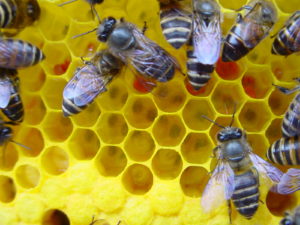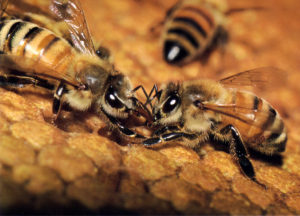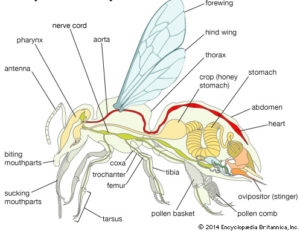When a worker honey bee is foraging among flowers she is collecting nectar. This natural sugary substance is broken down within the honey bee (specifically inside of the crop or honey stomach) from complex sucrose to more basic fructose and glucose. This process is completed through an enzyme called invertase. When the worker bee arrives back to her nest, she then will regurgitate the inverted sugar substance into another worker bees mouth who will also do the same inversion and regurgitation process. The process will continue as such over several rounds of worker bees.
When the honey bees convert the nectar into honey there is a natural pasteurization process ( a process to kill pathogenic bacteria in order that food can be made to safe to eat). The worker bees within the colony will enable evaporation of excess water from they honey through high RPM (rotations per minute) via wing movement. Otherwise, too much moisture in the honey would cause it to spoil faster.
In addition, another constituent called glucose oxidase is added to the honey, which gives it an antimicrobial property. In fact, the high total sugar concentration in honey is able to inhibit most yeasts from fermenting within the honey. After the moisture has been properly reduced then the honey cells are capped and sealed. Over a certain amount of time and with ambient temperature the honey is mature. Please refer to this short video that describes the process with visuals.
Often times when people think of consumption of honey, it’s always related to honey as a food for people. Yet, doesn’t honey also serve as a food source for honey bees, as well? Why of course! During the annual seasons there is time called the dearth period when there is a shortage of nectar-producing flowers. This is a natural phenomenon, however can also occur more often than supposed to due to lack of rainfall, excess heat, etc. Thus honey bees store honey as a food source, in order to survive when these dearth periods occur. This stored honey is especially important for the brood to have a food source when they (specifically, drones and workers) grow into the larvae stage.
Once honeybees become adults they use other food sources for energy. Recently emerged adults need a high supply of energy and therefore require food high in carbohydrates, such as nectar and sugary plant material like honeydew. They also require pollen, a good protein source, which they use to help produce food for larvae as well as the queen. In addition, worker bees will collect water as well as a plant material called propolis, from which they mix with wax to help construct nests. It is only during the dearth period when adult honeybees will feed on the stored honey. In other words, not only is honey and its’ related products a food or medicine for people but is also a vital part to the survival and regeneration of honeybees.







